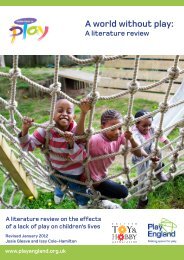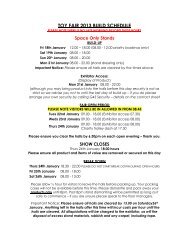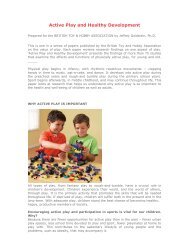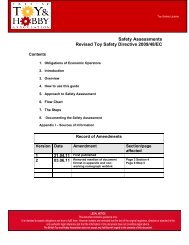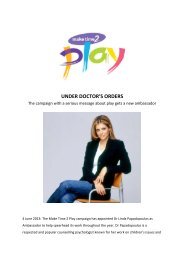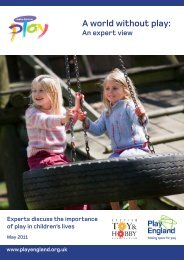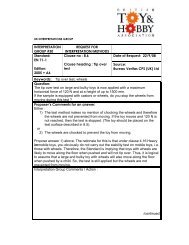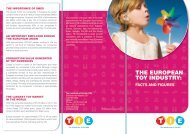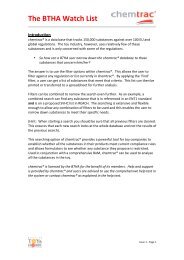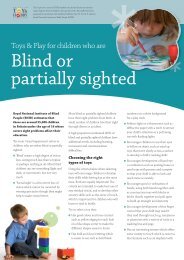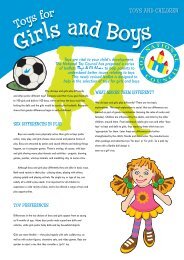Physical Activity and Body Image in Children - Make Time To Play
Physical Activity and Body Image in Children - Make Time To Play
Physical Activity and Body Image in Children - Make Time To Play
- No tags were found...
You also want an ePaper? Increase the reach of your titles
YUMPU automatically turns print PDFs into web optimized ePapers that Google loves.
<strong>Physical</strong> <strong>Activity</strong> <strong>and</strong> <strong>Body</strong> <strong>Image</strong> <strong>in</strong> <strong>Children</strong> A report by <strong>Make</strong> <strong>Time</strong> 2 <strong>Play</strong> with contributions <strong>and</strong> recommendations by Dr L<strong>in</strong>da Papadopoulos, Ambassador for <strong>Make</strong> <strong>Time</strong> 2 <strong>Play</strong> July 2013 1‘<strong>Physical</strong> <strong>Activity</strong> <strong>and</strong> <strong>Body</strong> <strong>Image</strong> <strong>in</strong> <strong>Children</strong>’: A report by <strong>Make</strong> <strong>Time</strong> 2 <strong>Play</strong>, July 2013
What is body image? The term body image refers to how an <strong>in</strong>dividual relates certa<strong>in</strong> factors such as their height, weight, shape, sk<strong>in</strong> colour <strong>and</strong> wider appearance with how they feel they look, their level of attractiveness <strong>and</strong> how they are perceived by others. Social <strong>and</strong> cultural forces play an important role <strong>in</strong> determ<strong>in</strong><strong>in</strong>g someone’s perception of their body image comb<strong>in</strong>ed with an <strong>in</strong>dividual’s personal experiences <strong>and</strong> personality. <strong>Body</strong> image <strong>in</strong> childhood Although body image concerns are often more commonly associated with older, adolescent children, research has shown that anxieties over how a child’s body image might be perceived by others starts to manifest itself at a much younger age. Nicky Hutch<strong>in</strong>son <strong>and</strong> Chris Call<strong>and</strong> (2011), two behaviour specialists <strong>and</strong> educational consultants, reported that three quarters of ten to eleven year olds <strong>in</strong>terviewed said that they would like to change their body image. These anxieties can often extend <strong>in</strong>to adulthood <strong>and</strong> it is important to prepare <strong>and</strong> advise children from an early age to help them to become resilient. An All Party Parliamentary Group (APPG) carried out a study on body image <strong>in</strong> 2012 <strong>and</strong> found that two out of three people <strong>in</strong> the UK are not happy with their body. It also found girls as young as five years old have concerns about how they look. Indeed, children <strong>and</strong> adolescents are two of the groups most likely to have concerns about their appearance. At the age of five, children start to notice differences among themselves <strong>and</strong> realise that they could be judged because of their appearance <strong>and</strong> this can develop <strong>in</strong>to real concerns later <strong>in</strong> life. Authors of the report from the Centre for appearance research commented that: “There is quite a lot of evidence that body dissatisfaction has emerged by about the age of 7 or 8 <strong>in</strong> both boys <strong>and</strong> girls.” Hutchison <strong>and</strong> Call<strong>and</strong> observed that: “By the end of primary school, at a time when children naturally put on a bit of weight, there was a real dip <strong>in</strong> body confidence.” The APPG’s study also revealed that over half of girls <strong>and</strong> a quarter of boys th<strong>in</strong>k their peers have body image problems <strong>and</strong> one <strong>in</strong> five people have been victimized about their weight. Furthermore, between one third <strong>and</strong> half of young girls fear becom<strong>in</strong>g fat <strong>and</strong> engage <strong>in</strong> diet<strong>in</strong>g or b<strong>in</strong>ge eat<strong>in</strong>g, with girls as young as five years old already worried about the way they look <strong>and</strong> their body size. The research found that one <strong>in</strong> four 7 year old girls have tried to lose weight at least once <strong>and</strong> that one third of young boys aged 8-‐12 are diet<strong>in</strong>g to lose weight. 3‘<strong>Physical</strong> <strong>Activity</strong> <strong>and</strong> <strong>Body</strong> <strong>Image</strong> <strong>in</strong> <strong>Children</strong>’: A report by <strong>Make</strong> <strong>Time</strong> 2 <strong>Play</strong>, July 2013
Celebrity culture (68%) was revealed as the most <strong>in</strong>fluential factor <strong>in</strong> shap<strong>in</strong>g children’s’ negative body self-‐image. Self awareness of one’s appearance <strong>and</strong> unhealthy body image messages can start surpris<strong>in</strong>gly young, as such it is important to teach children positive messages to overcome body image issues early on. One way of prepar<strong>in</strong>g children early is to encourage as much active play as possible. <strong>Play</strong> comes naturally to children <strong>and</strong> can be used to get children active <strong>and</strong> can be the catalyst for re<strong>in</strong>forc<strong>in</strong>g the positive body confidence messages which can potentially help children to become more resilient to negative body image <strong>in</strong>fluences <strong>in</strong> later life. <strong>Body</strong> image as a barrier to gett<strong>in</strong>g children active <strong>Children</strong>’s attitudes to what represents “healthy” are important factors <strong>in</strong> gett<strong>in</strong>g young people active. If children are too self conscious to engage <strong>in</strong> physical activity they are likely to be less healthy both as children <strong>and</strong> as they grow <strong>in</strong>to adulthood. It is important to ensure children perceive <strong>and</strong> engage with their bodies as functional as opposed to merely focus<strong>in</strong>g on the aesthetic. In its 2012 study on Girls Attitudes, the Girl Guides found that 23% of girls aged 7-‐21 who were <strong>in</strong>terviewed responded that they do not participate <strong>in</strong> exercise because they are unhappy with their body image. In the same study, 62% of girls <strong>in</strong>terviewed understood that be<strong>in</strong>g healthy meant tak<strong>in</strong>g part <strong>in</strong> lots of exercise. Furthermore, 29% of girls admitted that they were either “not very happy” or “not happy at all” with how they look. This compares with an equivalent figure of 17% for boys. There is also the perception among some girls that participat<strong>in</strong>g <strong>in</strong> active play <strong>and</strong> physical activity is not seen as a particularly fem<strong>in</strong><strong>in</strong>e pursuit. The Women’s Sport <strong>and</strong> Fitness Foundation found that 48% of girls thought that gett<strong>in</strong>g sweaty from tak<strong>in</strong>g part <strong>in</strong> sports is unfem<strong>in</strong><strong>in</strong>e <strong>and</strong> nearly a third of boys though that girls who are sporty are not very fem<strong>in</strong><strong>in</strong>e.The former Chair of UK Sports, Baroness Campbell commented <strong>in</strong> 2012 that many girls drop out of sport <strong>in</strong> their early teens because they start chang<strong>in</strong>g shape <strong>and</strong> they're less comfortable <strong>in</strong> their body (BBC website, 8 March, 2013) <strong>and</strong> the All Party Parliamentary Group study on body image observed that 60% of girls avoid certa<strong>in</strong> activities because of the way that they look. While body image concerns have traditionally been viewed as an issue associated with girls <strong>and</strong> young women, it would be <strong>in</strong>correct to assume that boys do not suffer from the same anxieties about their bodies which prevent them from tak<strong>in</strong>g part <strong>in</strong> sports <strong>and</strong> physical activities. 4‘<strong>Physical</strong> <strong>Activity</strong> <strong>and</strong> <strong>Body</strong> <strong>Image</strong> <strong>in</strong> <strong>Children</strong>’: A report by <strong>Make</strong> <strong>Time</strong> 2 <strong>Play</strong>, July 2013
The hyper-‐mascul<strong>in</strong>e ideal is becom<strong>in</strong>g commonplace <strong>and</strong> tends to dictate to boys from a young age what it means to be a man. Boys are told that be<strong>in</strong>g muscular <strong>and</strong> competitive even aggressive are aspirational qualities. For many boys who do not conform to these supposed ideals, this can lead to feel<strong>in</strong>gs of a lack of self-‐worth <strong>and</strong> anxieties over their body shape. The problem is made worse by an <strong>in</strong>creased likelihood that boys are less <strong>in</strong>cl<strong>in</strong>ed to discuss their emotions <strong>and</strong> concerns particularly when these are <strong>in</strong> relation to their bodies. (Kehler <strong>and</strong> Atk<strong>in</strong>son, 2010; Hargreaves <strong>and</strong> Tiggeman, 2006). A 2008 Canadian report entitled “It’s time to un-‐plug our kids,” noted that although rates of girls participat<strong>in</strong>g <strong>in</strong> activity as they enter adolescence rema<strong>in</strong>ed fairly stable over time, the rates of boys participation at the same age is actually decl<strong>in</strong><strong>in</strong>g, although total levels of boys rema<strong>in</strong>ed higher than girls. Michael Kehler <strong>and</strong> Michael Atk<strong>in</strong>son (2010) argue that as boys enter adolescence they do not demonstrate the body image that society tells them is desirable i.e. athletic <strong>and</strong> muscular which can leave them “vulnerable <strong>and</strong> open to scrut<strong>in</strong>y <strong>and</strong> ridicule by a privileged <strong>and</strong> powerful few.” Learn<strong>in</strong>g to combat unhealthy body self-‐image So what can be done to try to ensure children grow up to be happy <strong>and</strong> healthy adults? Psychologists have suggested that two of the factors that most affect body image are self esteem <strong>and</strong> mastery over the body (Grogan, 2002). Self-‐esteem is all about how people value themselves, the pride they feel <strong>in</strong> themselves, <strong>and</strong> how worthwhile they feel. It is important because it affects how a person acts, how they regulate their behaviour <strong>and</strong> how they relate to others. For many people, particularly younger people, body image can be closely l<strong>in</strong>ked to self-‐esteem. As children develop <strong>in</strong>to adolescence, they care more about how others see them. Positive self-‐esteem is key to psychological well-‐be<strong>in</strong>g. <strong>Children</strong> who have positive self-‐esteem are better able to cope with w<strong>in</strong>s <strong>and</strong> losses <strong>in</strong> games <strong>and</strong> <strong>in</strong> life. These enhanced cop<strong>in</strong>g skills can translate <strong>in</strong>to lifetime benefits <strong>in</strong>clud<strong>in</strong>g; Better mental health Better social skills More positive engagement with the world around them Less chance of conform<strong>in</strong>g to social pressure. Better body image 5‘<strong>Physical</strong> <strong>Activity</strong> <strong>and</strong> <strong>Body</strong> <strong>Image</strong> <strong>in</strong> <strong>Children</strong>’: A report by <strong>Make</strong> <strong>Time</strong> 2 <strong>Play</strong>, July 2013
Gett<strong>in</strong>g <strong>in</strong>volved <strong>in</strong> physical activities <strong>and</strong> active play can put children <strong>in</strong> touch with their body—they learn what their body can do <strong>and</strong> what it can’t. Active play teaches a child, from the earliest stages of its life, what its body is capable of; the development of physical skills, <strong>in</strong>creased levels of achievement (<strong>in</strong> strength, speed, balance <strong>and</strong> dexterity) <strong>and</strong> an underst<strong>and</strong><strong>in</strong>g of the functionality of its body – with a child never realis<strong>in</strong>g that this is someth<strong>in</strong>g they are learn<strong>in</strong>g. Referr<strong>in</strong>g specifically to girls, the United States Sports Academy commented: “Participat<strong>in</strong>g <strong>in</strong> sport is one way that girls can develop physical competence. Girls learn to appreciate their bodies for what they can do, <strong>in</strong>stead of the perceived appearance by oneself or by others.” <strong>Physical</strong> activities also create self-‐esteem through team build<strong>in</strong>g <strong>and</strong> healthy competition. When children are given the opportunity to reach out of their comfort zone to try someth<strong>in</strong>g new, beyond what they already know they can do. As they compete, they see themselves master<strong>in</strong>g new skills, which will give them the confidence to reach further <strong>and</strong> higher. Even when they don’t w<strong>in</strong>, they have the satisfaction of know<strong>in</strong>g they tried their hardest. This has a positive effect on resilience <strong>and</strong> self-‐esteem. Several studies have attested to the positive effects of physical activity on levels of self-‐esteem among children, suggest<strong>in</strong>g that physical fitness <strong>and</strong> vigorous physical activity levels contribute to a significant <strong>in</strong>crease <strong>in</strong> self-‐esteem <strong>in</strong> both boys <strong>and</strong> girls (Gruber, 1986; Percy, Dziuban <strong>and</strong> Mart<strong>in</strong>, 1981; Hatfield, Vaccaro <strong>and</strong> Benedict, 1985; Tremblay, Inman <strong>and</strong> Wilms, 2000; Schmalz, et al., 2007). Indeed, a report from the National Institute of Health which looked at the relationship between girls (ages 9 through 13) <strong>and</strong> their self-‐esteem concluded that; “promot<strong>in</strong>g physical activity among adolescent girls fosters positive self-‐worth”. People who have higher self-‐esteem tend to be more satisfied with their body image <strong>and</strong> those who have greater mastery over their bodies i.e.: those who use their bodies for physical purposes are likely to be more satisfied with their bodies <strong>and</strong> more hopeful of atta<strong>in</strong><strong>in</strong>g an ideal body shape. Even moderate exercise, which focuses on master<strong>in</strong>g the body rather than aesthetics, can improve self esteem <strong>and</strong> how we view our bodies (Brown <strong>and</strong> Lawton, 1986; M<strong>in</strong>tz <strong>and</strong> Betx, 1986; Furnham <strong>and</strong> Greaves, 1984; Furnham <strong>and</strong> Greaves, 1994). 6‘<strong>Physical</strong> <strong>Activity</strong> <strong>and</strong> <strong>Body</strong> <strong>Image</strong> <strong>in</strong> <strong>Children</strong>’: A report by <strong>Make</strong> <strong>Time</strong> 2 <strong>Play</strong>, July 2013
In 2002 Kirkcaldy, Shephard <strong>and</strong> Siefen of the International Center for the Study of Occupational <strong>and</strong> Mental Health <strong>in</strong> Dusseldorf carried out a study on the relationship between physical activity <strong>and</strong> self-‐image <strong>and</strong> problem behaviour among adolescents. The research found that young adolescents who engage <strong>in</strong> regular physical activity will display a more favourable self-‐image than their sedentary peers <strong>and</strong> are less likely to suffer from anxiety <strong>and</strong> depression. How <strong>and</strong> when to get kids <strong>in</strong>terested <strong>in</strong> activity So when is the optimum age to get children active <strong>and</strong> how do we keep their <strong>in</strong>terest <strong>in</strong> physical activity <strong>in</strong>to later life? A 2012 report found that a strong personal <strong>in</strong>terest <strong>in</strong> sport whilst grow<strong>in</strong>g up is the most important driver of tak<strong>in</strong>g part <strong>in</strong> later life. The f<strong>in</strong>d<strong>in</strong>gs highlighted that children who play sport regularly, build a strong attachment to sport from secondary school age. The type of sport they play at school is irrelevant – it is the passion for sport <strong>and</strong> physical activity <strong>in</strong> the early years that counts (YouGov, 2012). It is crucial that children are encouraged to build this strong attachment to physical activity, as research suggests that children with body image concerns are those who tend to be most anxious <strong>and</strong> resistant to engag<strong>in</strong>g <strong>in</strong> sport. An <strong>in</strong>terest <strong>in</strong> physical activity should be encouraged early <strong>in</strong> life when young children are keen to run around <strong>and</strong> be active, without th<strong>in</strong>k<strong>in</strong>g about it. At a very young age children may not have the co-‐ord<strong>in</strong>ation <strong>and</strong> dexterity (they have not yet fully developed motor skills) to take part <strong>in</strong> structured activities <strong>and</strong> sports. However they will be able to take part <strong>in</strong> play activities which help to develop these skills. A baby crawl<strong>in</strong>g after a ball is build<strong>in</strong>g muscle strength <strong>and</strong> <strong>in</strong> a basic form learn<strong>in</strong>g to “chase” the ball. A toddler might beg<strong>in</strong> to try to kick <strong>and</strong> throw the ball -‐ build<strong>in</strong>g dexterity <strong>and</strong> an underst<strong>and</strong><strong>in</strong>g of what their legs <strong>and</strong> arms are capable of as their balance <strong>and</strong> agility develop. <strong>Children</strong> should be encouraged <strong>in</strong> as much activity as possible – us<strong>in</strong>g a bat <strong>and</strong> ball to develop motor function <strong>and</strong> h<strong>and</strong>-‐eye co-‐ord<strong>in</strong>ation <strong>and</strong> kick<strong>in</strong>g balls, throw<strong>in</strong>g beanbags <strong>and</strong> runn<strong>in</strong>g <strong>and</strong> skipp<strong>in</strong>g – anyth<strong>in</strong>g that gets their bodies mov<strong>in</strong>g, elevates their heart rate, <strong>and</strong> teaches them about their body <strong>in</strong> terms of how it functions. Studies show that physical activity presents a physiological stress to the bra<strong>in</strong> that, when balanced with recovery, promotes adaptation <strong>and</strong> growth, preserves bra<strong>in</strong> function, <strong>and</strong> enables the bra<strong>in</strong> to respond to future challenges (Mattson, 2004). 7‘<strong>Physical</strong> <strong>Activity</strong> <strong>and</strong> <strong>Body</strong> <strong>Image</strong> <strong>in</strong> <strong>Children</strong>’: A report by <strong>Make</strong> <strong>Time</strong> 2 <strong>Play</strong>, July 2013
Aerobic activity also stimulates the release of neuronal growth factors (molecules that help neurons survive <strong>and</strong> thrive), promotes synaptic plasticity <strong>and</strong> long-‐term potentiation (dynamic modifications of the connections between neurons), <strong>and</strong> stimulates the growth of new neurons <strong>in</strong> the hippocampus (a bra<strong>in</strong> region primarily <strong>in</strong>volved <strong>in</strong> learn<strong>in</strong>g <strong>and</strong> memory) (Hillman, 2008). <strong>Physical</strong> activity helps children to develop mentally. Healthy emotional development takes many forms <strong>and</strong> will vary between children but it can help children to build resilience <strong>in</strong> areas that they may f<strong>in</strong>d challeng<strong>in</strong>g as they get older. The American Psychological Association (APA) describes resilience as “the process of adapt<strong>in</strong>g well <strong>in</strong> the face of adversity, trauma, tragedy, threats or significant sources of stress. It means "bounc<strong>in</strong>g back" from difficult experiences”. The APA suggests that one of the ways that children can develop resilience is by undertak<strong>in</strong>g regular exercise. This resonates <strong>in</strong> the work of the children’s charity Barnado’s which suggests that self-‐esteem is a key element of resilience. (Barnado’s, 2009). By engag<strong>in</strong>g <strong>in</strong> activity from a young age children ga<strong>in</strong> the numerous physical benefits of active play <strong>and</strong> sports, such as build<strong>in</strong>g muscle strength, improv<strong>in</strong>g cardiovascular fitness, develop<strong>in</strong>g co-‐ord<strong>in</strong>ation, develop<strong>in</strong>g dexterity, improv<strong>in</strong>g balance <strong>and</strong> agility <strong>and</strong> <strong>in</strong>creas<strong>in</strong>g endurance <strong>and</strong> speed (Goldste<strong>in</strong>, 2012). Not all children will take to structured activity like sports <strong>and</strong> this could be due to their age, preferences <strong>and</strong> access to facilities. Indeed unstructured activity is as important for children as learn<strong>in</strong>g the skill <strong>in</strong>volved <strong>in</strong> sports. Active play is one way of build<strong>in</strong>g physical activity <strong>in</strong>to the lives of all children. Early forms of physical activity start with repetitive, rhythmic movements, such as clapp<strong>in</strong>g h<strong>and</strong>s to music. As children get older this develops <strong>in</strong>to danc<strong>in</strong>g to music, rough <strong>and</strong> tumble play, <strong>and</strong> later on, participat<strong>in</strong>g <strong>in</strong> sport<strong>in</strong>g activities. For some children, structured sports will form an <strong>in</strong>tegral part of their daily lives but for others, sport<strong>in</strong>g activities may not grab their enthusiasm. Allow<strong>in</strong>g children the space <strong>and</strong> opportunity to just run around <strong>and</strong> play can give children unstructured benefits even if they are not “sporty”. A major benefit of participat<strong>in</strong>g <strong>in</strong> regular physical activity is an improvement <strong>in</strong> a child’s fitness levels <strong>and</strong> physical wellbe<strong>in</strong>g (Goldste<strong>in</strong>, 2012). 8‘<strong>Physical</strong> <strong>Activity</strong> <strong>and</strong> <strong>Body</strong> <strong>Image</strong> <strong>in</strong> <strong>Children</strong>’: A report by <strong>Make</strong> <strong>Time</strong> 2 <strong>Play</strong>, July 2013
In play, children learn how <strong>and</strong> when to express or control their emotions (Power, 2000). Rough-‐<strong>and</strong>-‐tumble is probably the most fundamental form of physical <strong>and</strong> active play <strong>in</strong> childhood. It <strong>in</strong>cludes activities such as runn<strong>in</strong>g, chas<strong>in</strong>g, play wrestl<strong>in</strong>g. Even play fight<strong>in</strong>g requires a good deal of self-‐control <strong>and</strong> restra<strong>in</strong>t, serv<strong>in</strong>g as practice for exercis<strong>in</strong>g restra<strong>in</strong>t <strong>in</strong> more serious contexts (Power, 2000; Galyer & Evans, 2001). For some parents it can be difficult to witness rough-‐<strong>and</strong>-‐tumble as it can be difficult to dist<strong>in</strong>guish from aggressive behaviour. Aggressive play is not the same as aggressive behaviour. It is important not to equate play-‐fight<strong>in</strong>g with serious fight<strong>in</strong>g <strong>and</strong> not to label a child as “aggressive” simply because he or she prefers a particular k<strong>in</strong>d of play (Power, 2000). In rough-‐<strong>and</strong>-‐tumble, children will be smil<strong>in</strong>g <strong>and</strong> laugh<strong>in</strong>g, <strong>and</strong> they will rema<strong>in</strong> together once they’re f<strong>in</strong>ished play<strong>in</strong>g. <strong>Children</strong> who are really fight<strong>in</strong>g will separate once the fight is over (Reed, 2005). It is important to look out for for signs that both children are hav<strong>in</strong>g fun <strong>and</strong> the “fight” is equal. If one child looks like they are be<strong>in</strong>g overpowered <strong>and</strong> not enjoy<strong>in</strong>g the play then it may have gone too far but normally children will tell each other when they have had enough <strong>and</strong> they learn clues from each other about how <strong>and</strong> when to stop. Rough-‐<strong>and</strong>-‐tumble usually <strong>in</strong>volves play<strong>in</strong>g with others <strong>and</strong> is related to social skills, status <strong>and</strong> emotional control (Pellegr<strong>in</strong>i & Smith, 1998; Reed, 2005). This k<strong>in</strong>d of active play, especially outdoors, burns more calories than other forms of play. It allows a physical release <strong>and</strong> may also help promote co-‐operation <strong>and</strong> facilitate friendship <strong>and</strong> prosocial behaviours. (Scott & Panksepp, 2003). <strong>Physical</strong> activity / play <strong>and</strong> emotional development The many benefits of play <strong>and</strong> sport extend beyond the physical factors <strong>and</strong> research shows the potential impact on <strong>in</strong>tellectual, emotional <strong>and</strong> social development-‐ <strong>in</strong>creased levels of creativity, greater will<strong>in</strong>gness to take risks, improved emotional self-‐regulation <strong>and</strong> generally <strong>in</strong>creased levels of happ<strong>in</strong>ess <strong>and</strong> confidence (Goldste<strong>in</strong>, 2012). In one study, 44 preschool children (22 boys, 22 girls) were <strong>in</strong>terviewed about their underst<strong>and</strong><strong>in</strong>g of emotion <strong>and</strong> the amount of pretend physical play with a same-‐sex friend from their preschool classroom was assessed. The f<strong>in</strong>d<strong>in</strong>gs suggested that emotion regulation <strong>and</strong> emotion underst<strong>and</strong><strong>in</strong>g (part of what is meant by ‘emotional <strong>in</strong>telligence’) make unique contributions to teacher rat<strong>in</strong>gs of children's emotional competence with peers. 9‘<strong>Physical</strong> <strong>Activity</strong> <strong>and</strong> <strong>Body</strong> <strong>Image</strong> <strong>in</strong> <strong>Children</strong>’: A report by <strong>Make</strong> <strong>Time</strong> 2 <strong>Play</strong>, July 2013
Different patterns of associations were found for boys <strong>and</strong> girls. High levels of pretend play were associated with greater emotional underst<strong>and</strong><strong>in</strong>g for both boys <strong>and</strong> girls, <strong>and</strong> with greater emotion regulation <strong>and</strong> emotional competence for girls. <strong>Physical</strong> play was associated with boys' emotional competence with peers (L<strong>in</strong>dsey & Colwell, 2003). Involvement <strong>in</strong> physical activities <strong>in</strong> childhood Young people’s anxieties related to their body image can translate through to an unwill<strong>in</strong>gness to participate <strong>in</strong> physical activity <strong>and</strong> hence miss<strong>in</strong>g out on the many benefits that it has to offer. However, moderate exercise which places the focus on enjoy<strong>in</strong>g <strong>and</strong> master<strong>in</strong>g the body, rather than appearance <strong>and</strong> weight is an important step to improv<strong>in</strong>g body image (Grogan, 2002). There are a number of factors which may predispose a child to be more engaged <strong>in</strong> activity. The activity level of parents will have an impact on their child’s activity. In one study, children of active mothers were found to be 2.0 times as likely to be active as the children of <strong>in</strong>active mothers. When both parents were active, the children were 5.8 times as likely to be active as the children of two <strong>in</strong>active parents. The study suggested the relationship between parents' <strong>and</strong> child's activity levels <strong>in</strong>cluded the parents' serv<strong>in</strong>g as role models, shar<strong>in</strong>g of activities by family members, enhancement <strong>and</strong> support by active parents of their child's participation <strong>in</strong> physical activity, <strong>and</strong> genetically transmitted factors that predispose the child to <strong>in</strong>creased levels of physical activity. (Moore et al., 1991) Early <strong>in</strong>troduction to active play <strong>and</strong> the activities chosen may also have a bear<strong>in</strong>g on later activity participation. Studies have shown that girls who engage <strong>in</strong> active play as children are more likely later to be <strong>in</strong>volved <strong>in</strong> sport. Eighty-‐four American female university students (40 compet<strong>in</strong>g athletes <strong>and</strong> 44 non-‐athletes) completed a questionnaire that measured their adult experiences with sports as well as their childhood play activities. The results revealed that play<strong>in</strong>g with ‘mascul<strong>in</strong>e’ toys <strong>and</strong> games, play<strong>in</strong>g <strong>in</strong> predom<strong>in</strong>antly male or mixed-‐gender groups, <strong>and</strong> be<strong>in</strong>g considered a ‘tomboy’ dist<strong>in</strong>guished between women who later became college athletes <strong>and</strong> those who did not. These f<strong>in</strong>d<strong>in</strong>gs suggest that childhood play activities should be considered, along with other agents of socialisation (family, peers, coaches), as important factors <strong>in</strong> predict<strong>in</strong>g future sport participation by females (Giuliano, 2000). 10‘<strong>Physical</strong> <strong>Activity</strong> <strong>and</strong> <strong>Body</strong> <strong>Image</strong> <strong>in</strong> <strong>Children</strong>’: A report by <strong>Make</strong> <strong>Time</strong> 2 <strong>Play</strong>, July 2013
A child’s personal <strong>in</strong>volvement <strong>in</strong> physical activities is determ<strong>in</strong>ed by a number of factors <strong>in</strong>clud<strong>in</strong>g genetics, the environment-‐ <strong>in</strong>clud<strong>in</strong>g society, family, school <strong>and</strong> peers, emotional stability <strong>and</strong> hormone levels. How to make change Increas<strong>in</strong>g levels of physical activity among children <strong>in</strong> schools is complicated. Accord<strong>in</strong>g to a report from the <strong>Children</strong>’s Institute of Learn<strong>in</strong>g & Development (2004), schools under pressure to academically achieve are decreas<strong>in</strong>g children’s opportunities to participate <strong>in</strong> break periods <strong>and</strong> physical education. However, while it might be the case that schools may not be provid<strong>in</strong>g children with as many opportunities to play <strong>in</strong> a structured fashion – dur<strong>in</strong>g PE lessons or breaks from lesson – a study <strong>in</strong> 2012 by the British <strong>To</strong>y <strong>and</strong> Hobby Association <strong>and</strong> Loughborough University’s Institute for Youth Sport found that even when children were given these opportunities, they did not engage <strong>in</strong> as much moderate to physical activity as they did when they were given time to simply enjoy unstructured play with an activity toy or toy substitute such as a cardboard box. PE lessons teach children new skills to engage <strong>in</strong> sports but may not necessarily give children the opportunity to be extremely active (particularly for an entire lesson). The important lesson learnt was that children were more active when they were simply given the time to enjoy play free of restrictions <strong>and</strong> structure. Schools can play a vital role <strong>in</strong> educat<strong>in</strong>g <strong>and</strong> prepar<strong>in</strong>g children for body awareness issues <strong>and</strong> cover some of the issues through the curriculum -‐ with a possible qualification <strong>in</strong> body image be<strong>in</strong>g launched <strong>in</strong> 2013. Resources such as Media Smart’s body image lesson also help children to underst<strong>and</strong> the issues <strong>and</strong> discuss them <strong>in</strong> schools.The Department for Culture, Media <strong>and</strong> Sport, as part of the government’s <strong>Body</strong> Confidence Campaign, has hosted a series of roundtable discussions on women’s participation <strong>in</strong> sport <strong>and</strong> is cont<strong>in</strong>u<strong>in</strong>g its work <strong>in</strong> this area by host<strong>in</strong>g workshops on promot<strong>in</strong>g sports as a lifestyle choice for young women. More could be done by acknowledg<strong>in</strong>g active play as part of that activity mix <strong>in</strong> order to target younger children <strong>and</strong> those who do not necessarily want to take part <strong>in</strong> structured activity. Parents can help children outside of the school environment by show<strong>in</strong>g children that tak<strong>in</strong>g part <strong>in</strong> physical activities can be reward<strong>in</strong>g <strong>and</strong> enjoyable <strong>and</strong> does not require Olympian st<strong>and</strong>ard physical attributes or an overly competitive nature. 11‘<strong>Physical</strong> <strong>Activity</strong> <strong>and</strong> <strong>Body</strong> <strong>Image</strong> <strong>in</strong> <strong>Children</strong>’: A report by <strong>Make</strong> <strong>Time</strong> 2 <strong>Play</strong>, July 2013
<strong>Play</strong> <strong>in</strong> its many forms should be encouraged both <strong>in</strong> <strong>and</strong> outside the school. A variety of activities can help children to discover what they do <strong>and</strong> don’t like. The nature of the activity is irrelevant as the studies show that active children have more chance of develop<strong>in</strong>g <strong>in</strong>to physically <strong>and</strong> psychologically healthy adults. Teach<strong>in</strong>g children to value their body for “what it can do” not simply for “how it looks” is an important way of combatt<strong>in</strong>g potential unhealthy body image. If children underst<strong>and</strong> the concept of body function they look at themselves for what they can do rather than what they look like. <strong>Children</strong> should be taught that their bodies are fast, strong, flexible <strong>and</strong> agile rather than just pretty or h<strong>and</strong>some. Recognis<strong>in</strong>g the warn<strong>in</strong>g signs of an unhealthy body image <strong>in</strong> children can help parents identify problems early. Parents should watch <strong>and</strong> listen out for certa<strong>in</strong> factors such as the language children are us<strong>in</strong>g – are they frequently comment<strong>in</strong>g on their body size or appearance or <strong>in</strong>deed those of others? Do they have low self-‐ esteem? Also, parents should look out for behaviour that might suggest that their child is try<strong>in</strong>g to change their body shape – are they avoid<strong>in</strong>g meal times <strong>and</strong> embark<strong>in</strong>g on excessive diet<strong>in</strong>g? (womenshealth.gov, 2013) Parents can also help children overcome a negative body image by speak<strong>in</strong>g to their children <strong>and</strong> help<strong>in</strong>g them underst<strong>and</strong> that there is no ideal body image. Try to avoid any pressure be<strong>in</strong>g put on children to conform to a certa<strong>in</strong> ideal <strong>and</strong> be m<strong>in</strong>dful of the language used to discuss images which can <strong>in</strong>fluence body image, avoid<strong>in</strong>g negative words. Encourag<strong>in</strong>g children to participate <strong>in</strong> organised physical activities as well as unstructured free play is <strong>in</strong>tegral to physical <strong>and</strong> emotional wellbe<strong>in</strong>g as part of a wider healthy lifestyle. Parents can encourage physical activity by <strong>in</strong>creas<strong>in</strong>g their own fitness levels. Plan activities for the entire family; this might <strong>in</strong>clude a walk around the neighbourhood, a game of rounders <strong>in</strong> the park, a water fight on a sunny day or a backyard race. Conclusion <strong>and</strong> comments by Dr L<strong>in</strong>da Papadopoulos – Ambassador for <strong>Make</strong> <strong>Time</strong> 2 <strong>Play</strong> This report has focused the many benefits that play <strong>and</strong> physical activity is proven to develop <strong>in</strong> the physical <strong>and</strong> emotional growth of healthy children <strong>and</strong> how participat<strong>in</strong>g <strong>in</strong> these activities on a regular basis can help children to develop healthy levels of resilience, self esteem <strong>and</strong> confidence -‐ all of which contribute to how they view their bodies. The l<strong>in</strong>k between an <strong>in</strong>crease <strong>in</strong> physical exercise <strong>and</strong> improved self-‐esteem, particularly dur<strong>in</strong>g childhood <strong>and</strong> adolescence, is supported by a wide body of research. However there is also plenty of evidence to suggest that today’s young people are more body conscious than <strong>in</strong> previous times <strong>and</strong> becom<strong>in</strong>g so at an <strong>in</strong>creas<strong>in</strong>gly younger age. 12‘<strong>Physical</strong> <strong>Activity</strong> <strong>and</strong> <strong>Body</strong> <strong>Image</strong> <strong>in</strong> <strong>Children</strong>’: A report by <strong>Make</strong> <strong>Time</strong> 2 <strong>Play</strong>, July 2013
While it is true that children are now exposed to TV., media, celebrity culture <strong>and</strong> peer pressure on a level that previous generations were not, which can all play an important role <strong>in</strong> how they feel about themselves <strong>and</strong> their bodies, it is apparent that participat<strong>in</strong>g <strong>in</strong> play <strong>and</strong> physical activities from a young age can overcome many anxieties that might otherwise manifest themselves as children face issues relat<strong>in</strong>g to their bodies <strong>and</strong> their sense of self worth. Certa<strong>in</strong>ly engag<strong>in</strong>g <strong>in</strong> active play <strong>and</strong> physical activities can teach children about their body for what it can do rather than what it looks like, can teach them about master<strong>in</strong>g new skills <strong>and</strong> give them the confidence to stretch themselves, positively impact<strong>in</strong>g on the resilience <strong>and</strong> self-‐esteem that may help them overcome later pressures <strong>and</strong> <strong>in</strong>hibitions. It is <strong>in</strong>terest<strong>in</strong>g to note that children who develop an <strong>in</strong>terest <strong>in</strong> sports from a young age are more likely to reta<strong>in</strong> this <strong>in</strong>terest as they grow <strong>in</strong>to adults. However this does not necessarily mean that children need to be <strong>in</strong>terested <strong>in</strong> sports to be physically active. What is also worth not<strong>in</strong>g is that when children are simply given the time to enjoy play without rules, restrictions <strong>and</strong> boundaries, <strong>in</strong> an unstructured sett<strong>in</strong>g, that they are more physically active than dur<strong>in</strong>g the more traditional times set aside for physical activity such as PE lessons. It is never too late to get children <strong>in</strong>volved <strong>in</strong> physical activities – whether this is a sport<strong>in</strong>g pursuit or simply play<strong>in</strong>g more. They do not need to be of Olympian st<strong>and</strong>ard <strong>and</strong> they should not be forced <strong>in</strong>to tak<strong>in</strong>g part <strong>in</strong> activities that do not suit them or make them feel uncomfortable. There is a whole world of activities out there wait<strong>in</strong>g to be discovered that get the heart pump<strong>in</strong>g <strong>and</strong> the adrenal<strong>in</strong>e flow<strong>in</strong>g. For parents, the key is encourag<strong>in</strong>g children to f<strong>in</strong>d the activity that suits them. When they f<strong>in</strong>d this activity that lights a spark <strong>in</strong>side of them they will soon start to enjoy the many benefits that regular physical exercise has to offer <strong>and</strong> they will also soon ga<strong>in</strong> an appreciation of what their body can do, rather than what it looks like. This is fundamental to improv<strong>in</strong>g how they view themselves <strong>and</strong> their bodies. Recommendations 1. The way we value active play, sport <strong>and</strong> health will contribute to how children value their bodies: as such, policy that focuses on enhanc<strong>in</strong>g children’s activity both <strong>in</strong> <strong>and</strong> out of school, structured <strong>and</strong> unstructured, will be <strong>in</strong>tegral <strong>in</strong> gett<strong>in</strong>g children to engage more <strong>and</strong> potentially have a positive impact on their body confidence. Whether it’s provid<strong>in</strong>g time <strong>and</strong> space for 13‘<strong>Physical</strong> <strong>Activity</strong> <strong>and</strong> <strong>Body</strong> <strong>Image</strong> <strong>in</strong> <strong>Children</strong>’: A report by <strong>Make</strong> <strong>Time</strong> 2 <strong>Play</strong>, July 2013
play or encourag<strong>in</strong>g play <strong>and</strong> sports ambassadors to <strong>in</strong>spire children <strong>and</strong> young people, the promotion of the idea that society values <strong>and</strong> acknowledges the benefits of activity is important. 2. Model appropriate behaviour: if your children see you be<strong>in</strong>g active, <strong>and</strong> hav<strong>in</strong>g a positive outlook on physical activity <strong>and</strong> enjoy<strong>in</strong>g what your body can do they are much more likely to follow suit. <strong>Play</strong>fulness is <strong>in</strong>fectious. 3. You don't need to be the best at it to enjoy it: many kids <strong>and</strong> even adults shy away from sports <strong>and</strong> physical activities because they don't feel they can do them well enough. So speak about activity <strong>in</strong> terms of it be<strong>in</strong>g fun, gett<strong>in</strong>g to connect with new people <strong>and</strong> ga<strong>in</strong><strong>in</strong>g confidence by test<strong>in</strong>g your physical limits. Don't let the fact that you’re not an Olympic level athlete get <strong>in</strong> the way of enjoy<strong>in</strong>g an activity you enjoy – no matter what age you are, a physical activity that you enjoy do<strong>in</strong>g <strong>and</strong> see as fun is, after all, playtime. 4. Beware of how you compliment: whist tell<strong>in</strong>g children they look nice is f<strong>in</strong>e it’s also really important that you validate them for what they can do-‐ how fast they run; how well they throw; what great sportsmanship they show. They need to see <strong>and</strong> value their bodies for what they can do more than for what they look like-‐ draw<strong>in</strong>g attention to their physical abilities <strong>and</strong> behaviours <strong>and</strong> validat<strong>in</strong>g them for this is vital. 5. You’re <strong>in</strong> competition with no one but yourself: underscore the idea that physical efforts are about personal goals <strong>and</strong> that the key to enjoy<strong>in</strong>g them <strong>and</strong> feel<strong>in</strong>g that sense of mastery is through sett<strong>in</strong>g personal goals rather than try<strong>in</strong>g to impress or ‘beat’ anyone else. 6. Schools need to offer variety: both <strong>in</strong> terms of the activities they offer but also <strong>in</strong> terms of how these are played-‐ for example <strong>in</strong> some circumstances mixed gender teams may promote a sense of unity while activities that don't have a competitive component can still contribute to an overall sense of well be<strong>in</strong>g <strong>and</strong> accomplishment. 7. Promot<strong>in</strong>g gender equality: The idea that there are girls’ sports <strong>and</strong> boys’ sports is often promoted from a very early age. It’s vital that children are encouraged to play a range of sports <strong>and</strong> not feel restricted from try<strong>in</strong>g someth<strong>in</strong>g new because it doesn't fit <strong>in</strong>to a specific gender stereotype. 8. Policy change to ensure that schools talk about body image <strong>in</strong> PSHE: giv<strong>in</strong>g children the tools to underst<strong>and</strong> how their body image is affected by the messages they see from the world around them is vital, as is giv<strong>in</strong>g them the tools to cope with this. Hav<strong>in</strong>g a structured, developmentally appropriate programme that addresses this <strong>in</strong> schools could go along way <strong>in</strong> address<strong>in</strong>g issues of self esteem, body image <strong>and</strong> health. 14‘<strong>Physical</strong> <strong>Activity</strong> <strong>and</strong> <strong>Body</strong> <strong>Image</strong> <strong>in</strong> <strong>Children</strong>’: A report by <strong>Make</strong> <strong>Time</strong> 2 <strong>Play</strong>, July 2013
Bibliography Active Healthy Kids Canada report (2008) – Its time to un-‐plug our kids All Party Parliamentary Group (APPG) on <strong>Body</strong> <strong>Image</strong> Report (2012) – Reflections of <strong>Body</strong> <strong>Image</strong> Brown, J.D. <strong>and</strong> Lawton, M. (1986) -‐ Stress <strong>and</strong> Well-‐Be<strong>in</strong>g <strong>in</strong> Adolescence: The Moderat<strong>in</strong>g Role of <strong>Physical</strong> Exercise Brown, Pei-‐San, Sutterby, John A. <strong>and</strong> Thornton C<strong>and</strong>ra D, <strong>Children</strong>’s Institute of Learn<strong>in</strong>g & Development (2004) -‐ Combatt<strong>in</strong>g childhood obesity with physical play opportunities Call<strong>and</strong>, Chris <strong>and</strong> Hutchison Nicky (2011) -‐ <strong>Body</strong> <strong>Image</strong> <strong>in</strong> the Primary School. Furnham A <strong>and</strong> Greaves N (1994) -‐ Gender <strong>and</strong> locus of control correlates of body image dissatisfaction Gayler, K.T., & Evans, I.M. (2001) -‐ Pretend play <strong>and</strong> the development of emotion regulation <strong>in</strong> preschool children Girls’ Attitudes Survey (2012) -‐ Girl Guid<strong>in</strong>g UK Giuliano (2000) – Footballs vs Barbies: Childhood play activities as predictors of sport participation by women Glover, Jane for Barnado’s (2009) -‐ Bounc<strong>in</strong>g Back – How Resilience can be promoted <strong>in</strong> vulnerable children <strong>and</strong> young people Goldste<strong>in</strong>, Dr Jeffrey for the British <strong>To</strong>y <strong>and</strong> Hobby Association (2012) -‐ Active <strong>Play</strong> <strong>and</strong> Healthy Development. Grogan, Sarah (2002) -‐ <strong>Body</strong> <strong>Image</strong> : Underst<strong>and</strong><strong>in</strong>g <strong>Body</strong> Dissatisfaction <strong>in</strong> Men, Women, <strong>and</strong> <strong>Children</strong>Gruber JJ (1986) – <strong>Physical</strong> activity <strong>and</strong> self-‐esteem development <strong>in</strong> children: A meta-analysisHargreaves D.A. <strong>and</strong> Tiggeman M (2006) ‘<strong>Body</strong> image is for girls’: a qualitative study of boys' body image 15‘<strong>Physical</strong> <strong>Activity</strong> <strong>and</strong> <strong>Body</strong> <strong>Image</strong> <strong>in</strong> <strong>Children</strong>’: A report by <strong>Make</strong> <strong>Time</strong> 2 <strong>Play</strong>, July 2013
Hatfield, Vaccaro <strong>and</strong> Benedict (1983) – Self-‐concept responses of children to participation <strong>in</strong> an eight week precision jump-‐rope program. Perceptual <strong>and</strong> Motor Skills. The Institute of Youth Sport, Loughborough University for the British <strong>To</strong>y <strong>and</strong> Hobby Association (2012) -‐ The Impact of <strong>To</strong>ys <strong>and</strong> <strong>Play</strong> on <strong>Children</strong>’s <strong>Physical</strong> <strong>Activity</strong> Kehler, Michael <strong>and</strong> Atk<strong>in</strong>son, Michael (2010) – Boys’ Bodies – Speak<strong>in</strong>g the Unspoken Kirkcaldy B.D, Shephard R.J <strong>and</strong> Siefen R.G -‐ International Center for the Study of Occupational <strong>and</strong> Mental Health <strong>in</strong> Dusseldorf (2002) -‐ The relationship between physical activity <strong>and</strong> self-‐image <strong>and</strong> problem behaviour among adolescents L<strong>in</strong>dsey, Eric W & Colwell, Mal<strong>in</strong>da J (2003) -‐ Preschoolers' emotional competence: L<strong>in</strong>ks to pretend <strong>and</strong> physical play (Child Study Journal) Mattson (2004) -‐ Pathways towards <strong>and</strong> away from Alzheimers disease Hillman (2008) – Be smart, exercise your heart: exercise effects on bra<strong>in</strong> <strong>and</strong> cognition M<strong>in</strong>tz L <strong>and</strong> Betz N.E. (1986) – Sex differences <strong>in</strong> the nature, realism <strong>and</strong> correlates of body image Moore LL, Lombardi DA, White MJ, Campbell JL, Oliveria SA, Ellison RC, Evans Department of Medic<strong>in</strong>e, Boston University School of Medic<strong>in</strong>e, Massachusetts (1991) -‐ Influence of parents' physical activity levels on activity levels of young children National Institute of Health study (2007) -‐ Relationship between girls (ages 9 through 13) Pellegr<strong>in</strong>i, Anthony D., & Smith, Peter K. (1998) -‐ <strong>Physical</strong> activity play. The Nature <strong>and</strong> Function of a Neglected Aspect of <strong>Play</strong> Percy, Dzubian <strong>and</strong> Mart<strong>in</strong> (1981) – Analysis of the effects of distance runn<strong>in</strong>g on the self-‐concepts of elementary students. Perceptual <strong>and</strong> Motor Skills. Power, Thomas G. (2000) -‐ <strong>Play</strong> <strong>and</strong> exploration <strong>in</strong> children <strong>and</strong> animals. London: Lawrence Erlbaum Associates. 16‘<strong>Physical</strong> <strong>Activity</strong> <strong>and</strong> <strong>Body</strong> <strong>Image</strong> <strong>in</strong> <strong>Children</strong>’: A report by <strong>Make</strong> <strong>Time</strong> 2 <strong>Play</strong>, July 2013
Reed, Thomas L. (2005) -‐ A qualitative approach to boys rough <strong>and</strong> tumble play: There is more than meets the eye. In F. F. McMahon, D. E. Lytle & B. Sutton-‐Smith (eds.), <strong>Play</strong> an <strong>in</strong>terdiscipl<strong>in</strong>ary synthesis. <strong>Play</strong> & Culture Studies, vol. 6. Lanham, MD: University Press of America. Sattelmair, Jacob <strong>and</strong> <strong>and</strong> Ratey John J. (2009) -‐ <strong>Physical</strong>ly Active <strong>Play</strong> <strong>and</strong> Cognition-‐An Academic Matter? Schmalz, Dorothy L., <strong>and</strong> others (2007) -‐ A longitud<strong>in</strong>al assessment of the l<strong>in</strong>ks between physical activity <strong>and</strong> self-‐esteem <strong>in</strong> early adolescent non-‐Hispanic females. (Journal of Adolescent Health) Scott, Eric, & Panksepp, Jaak. (2003) -‐ Rough-‐<strong>and</strong>-‐tumble play <strong>in</strong> human children. Aggressive Behavior. Tremblay, M.S., Inman, J.W., <strong>and</strong> Willms, J.D. (2000) -‐ The relationship between physical activity, self-‐esteem, <strong>and</strong> academic achievement <strong>in</strong> 12-‐year-‐old children. Walters, Scott T, Mart<strong>in</strong>, John E (2000) Does Aerobic Exercise Really Enhance Self-‐Esteem <strong>in</strong> <strong>Children</strong>? A Prospective Evaluation <strong>in</strong> 3rd -‐ 5th Graders. Women’s Sport <strong>and</strong> Fitness Foundation (2012) -‐ Chang<strong>in</strong>g the game for girls YouGov for Sport Engl<strong>and</strong> (2012) -‐ Sport<strong>in</strong>g Habit for Life Websites www.apa.org -‐ American Psychological Association (APA) “What is resilience?” www.bbc.co.uk (BBC Sports 8 March 2013) -‐ Hold<strong>in</strong>g out for role models, not glamour models www.discoveryourdaughter.com -‐ Self-‐Esteem <strong>in</strong> Teen Girls: How to Help Your Daughter Have Improved Self-‐Esteem www.gov.uk/geo/body-‐confidence -‐ UK Government’s <strong>Body</strong> Confidence campaign www.healthyalberta.com -‐ Build<strong>in</strong>g Self-‐Esteem through sports www.livestrong.org -‐ Exercise Facts for Kids 17‘<strong>Physical</strong> <strong>Activity</strong> <strong>and</strong> <strong>Body</strong> <strong>Image</strong> <strong>in</strong> <strong>Children</strong>’: A report by <strong>Make</strong> <strong>Time</strong> 2 <strong>Play</strong>, July 2013
www.mediasmart.org -‐ Media Smart’s <strong>Body</strong> <strong>Image</strong> campaign www.ussa.edu -‐ United States Sports Academy 18‘<strong>Physical</strong> <strong>Activity</strong> <strong>and</strong> <strong>Body</strong> <strong>Image</strong> <strong>in</strong> <strong>Children</strong>’: A report by <strong>Make</strong> <strong>Time</strong> 2 <strong>Play</strong>, July 2013



